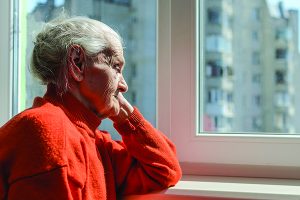From frontline to quarantine

It is June 12, 2020. Seattle has entered “Modified Phase 1” during the COVID-19 pandemic. Restaurants are reopening with social distancing, and hair stylists are open for appointments with appropriate screening and masks. It all seems like another planet as I enter the nursing home in Queen Anne to see a new patient. Signs posted on the entry door to the COVID wing direct all incoming providers to observe “Droplet Precautions” with masks, eye protection, gowns and gloves prior to entry. Visitors are allowed to see a resident only at the “end of life.”
The facility is even quieter than usual, and I notice a gathering of all staff in the dining room, just concluding a meeting. There are many staff members I know, and I see some with tears in their eyes as they are coming into the hall. As everyone lines up prior to entry to the COVID wing, they help each other tie their gowns from behind. I mention that this is a “very hard time to work in nursing homes.” One assistant turns to me saying, “I wish that it would all just be over.” Only later do I learn that their meeting was to announce the pending withdrawal of life support for a colleague who has been hospitalized with COVID-19 and on a ventilator.
I could not have imagined this change in the world of nursing homes four months ago. I have worked in nursing homes in the Seattle area for 26 years doing skilled nursing care, palliative care and long-term custodial care. This has always been an environment structured to provide care in a social and family-oriented environment. Facilities have recognized holidays and birthdays with parties. Volunteers come to play music for residents, and pets are brought in to provide love and nurturing. Now families can only come to the window and hold up signs or talk on cell phones to their loved ones.
My entry into this new and strange world was abrupt. I remember vividly my visit on February 26 to the Life Care Center in Kirkland. I first noticed concern on the faces of nurses coming down the hall, reporting fevers on several patients. Influenza tests came back negative. When I got back to my office, I commented to my colleagues that it was very strange to see the cluster of fevers without influenza in the nursing home. Two days later, the patients who had been admitted at Evergreen Hospital tested positive for COVID-19, representing the first-identified outbreak of the pandemic in the United States. Forty-three residents of Life Care died within the next month.
I entered quarantine at home beyond the 14 days required following my visit to the Life Care Center in February. I remained well throughout my quarantine and felt increasingly restless just waiting for the time to pass. I gave up a planned evening of live salsa dancing to which I had purchased tickets. I went on walks and bike rides alone and managed a solo cross-country ski outing on empty trails in the Cascades. It seemed odd and difficult to remain away from family members while I felt fairly confident that the precautions I was taking would protect me from becoming ill. Yet, I also sensed the reluctance of close acquaintances to violate the quarantine. It was indeed a time of being alone.
As I enter the final years of my medical career, writing about my experiences caring for patients has become an increasingly important way to articulate my feelings of loss. Isolation in quarantine represented a reversal in my role; now I was the one being shunned for fear of exposure to illness and contagion.
Seeing things from others’ perspective is an underdeveloped skill in our culture. COVID-19 is bringing my colleagues and me to a new depth of feeling and understanding of the social isolation and loss that patients and their families experience regularly. In a similar way, many across our nation are soul-searching around our collective neglect of the injustices suffered by people of color throughout history, in response to the taken lives of George Floyd and others.
Events of this year have broken us open to see realities we’ve always lived close to, but never dared touch. As we come through this time, my hope is that our newfound openness to the pain of others can help us remain more compassionate and fair to those we love, serve and walk alongside in this world.
Covid Tale
The “Red Death” had long devastated the country.
No pestilence had ever been so fatal or so hideous.
—Edgar Allan Poe
Like a leper outside the gates
I can see the upturned brows,
eyes that glance away, faces
drawn tight to quell the drum
beating within their chests.
Passersby on city streets
avoid each other, listening
for sniffles, watching for hands
touching eyes and nose, for hands
reaching out in proffered greeting.
Signs held up to elders kept
behind shuttered windows
give sympathy for their plight,
“Jesus is with you”, they say
“even if we cannot come”.
Racing to shelves swept clean
in stores emptied of goods,
masks are worn like amulets
to ward away exhaled humors
of unseen scowling demons.
Fetid winds seep under doors,
foreign yellow faces seen
as “other” steal away breath
of those unaware, those lain
to rest under red-stained shrouds.
The healer now one of the exposed,
my masked face spurned invitation
to the macabre dance, left alone
away from the undulating limbs
that await the stroke of the hour.
Behind the red-horned mask
laughter comes, a voice echoes
“suffer not these fools”, such
are born alone to an illusion
that all of this will remain.
—David True
View Dr. True’s poem alongside other COVID-related contributions on the Washington State Poet Laureate’s blog. (Search for David True on the page)



